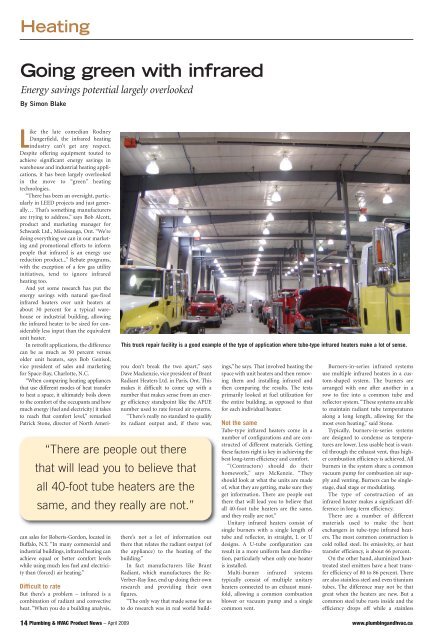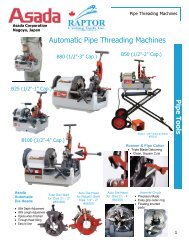phvac Dec 2006.qxd - Plumbing & HVAC
phvac Dec 2006.qxd - Plumbing & HVAC
phvac Dec 2006.qxd - Plumbing & HVAC
You also want an ePaper? Increase the reach of your titles
YUMPU automatically turns print PDFs into web optimized ePapers that Google loves.
Heating<br />
Going green with infrared<br />
Energy savings potential largely overlooked<br />
By Simon Blake<br />
Like the late comedian Rodney<br />
Dangerfield, the infrared heating<br />
industry can’t get any respect.<br />
Despite offering equipment touted to<br />
achieve significant energy savings in<br />
warehouse and industrial heating applications,<br />
it has been largely overlooked<br />
in the move to “green” heating<br />
technologies.<br />
“There has been an oversight, particularly<br />
in LEED projects and just generally…<br />
That’s something manufacturers<br />
are trying to address,” says Bob Alcott,<br />
product and marketing manager for<br />
Schwank Ltd., Mississauga, Ont. “We’re<br />
doing everything we can in our marketing<br />
and promotional efforts to inform<br />
people that infrared is an energy use<br />
reduction product...” Rebate programs,<br />
with the exception of a few gas utility<br />
initiatives, tend to ignore infrared<br />
heating too.<br />
And yet some research has put the<br />
energy savings with natural gas-fired<br />
infrared heaters over unit heaters at<br />
about 30 percent for a typical warehouse<br />
or industrial building, allowing<br />
the infrared heater to be sized for considerably<br />
less input than the equivalent<br />
unit heater.<br />
In retrofit applications, the difference<br />
can be as much as 50 percent versus<br />
older unit heaters, says Bob Genisol,<br />
vice president of sales and marketing<br />
for Space-Ray, Charlotte, N.C.<br />
“When comparing heating appliances<br />
that use different modes of heat transfer<br />
to heat a space, it ultimately boils down<br />
to the comfort of the occupants and how<br />
much energy (fuel and electricity) it takes<br />
to reach that comfort level,” remarked<br />
Patrick Stone, director of North Ameri -<br />
can sales for Roberts-Gordon, located in<br />
Buffalo, N.Y. “In many commercial and<br />
industrial buildings, infrared heating can<br />
achieve equal or better comfort levels<br />
while using much less fuel and electricity<br />
than (forced) air heating.”<br />
Difficult to rate<br />
But there’s a problem – infrared is a<br />
combination of radiant and convective<br />
heat. “When you do a building analysis,<br />
you don’t break the two apart,” says<br />
Dave Mackenzie, vice president of Brant<br />
Radiant Heaters Ltd. in Paris, Ont. This<br />
makes it difficult to come up with a<br />
number that makes sense from an energy<br />
efficiency standpoint like the AFUE<br />
number used to rate forced air systems.<br />
“There’s really no standard to qualify<br />
its radiant output and, if there was,<br />
“There are people out there<br />
that will lead you to believe that<br />
all 40-foot tube heaters are the<br />
same, and they really are not.”<br />
This truck repair facility is a good example of the type of application where tube-type infrared heaters make a lot of sense.<br />
there’s not a lot of information out<br />
there that relates the radiant output (of<br />
the appliance) to the heating of the<br />
building.”<br />
In fact manufacturers like Brant<br />
Radiant, which manufactures the Re-<br />
Verber-Ray line, end up doing their own<br />
research and providing their own<br />
figures.<br />
“The only way that made sense for us<br />
to do research was in real world buildings,”<br />
he says. That involved heating the<br />
space with unit heaters and then removing<br />
them and installing infrared and<br />
then comparing the results. The tests<br />
primarily looked at fuel utilization for<br />
the entire building, as opposed to that<br />
for each individual heater.<br />
Not the same<br />
Tube-type infrared heaters come in a<br />
number of configurations and are constructed<br />
of different materials. Getting<br />
these factors right is key in achieving the<br />
best long-term efficiency and comfort.<br />
“(Contractors) should do their<br />
home work,” says McKenzie. “They<br />
should look at what the units are made<br />
of, what they are getting, make sure they<br />
get information. There are people out<br />
there that will lead you to believe that<br />
all 40-foot tube heaters are the same,<br />
and they really are not.”<br />
Unitary infrared heaters consist of<br />
single burners with a single length of<br />
tube and reflector, in straight, L or U<br />
designs. A U-tube configuration can<br />
result in a more uniform heat distribution,<br />
particularly when only one heater<br />
is installed.<br />
Multi-burner infrared systems<br />
typically consist of multiple unitary<br />
heaters connected to an exhaust manifold,<br />
allowing a common combustion<br />
blower or vacuum pump and a single<br />
common vent.<br />
Burners-in-series infrared systems<br />
use multiple infrared heaters in a custom-shaped<br />
system. The burners are<br />
arranged with one after another in a<br />
row to fire into a common tube and<br />
reflector system. “These systems are able<br />
to maintain radiant tube temperatures<br />
along a long length, allowing for the<br />
most even heating,” said Stone.<br />
Typically, burners-in-series systems<br />
are designed to condense as temperatures<br />
are lower. Less usable heat is wasted<br />
through the exhaust vent, thus higher<br />
combustion efficiency is achieved. All<br />
burners in the system share a common<br />
vacuum pump for combustion air supply<br />
and venting. Burners can be singlestage,<br />
dual stage or modulating.<br />
The type of construction of an<br />
infrared heater makes a significant difference<br />
in long-term efficiency.<br />
There are a number of different<br />
materials used to make the heat<br />
exchangers in tube-type infrared heat -<br />
ers. The most common construction is<br />
cold rolled steel. Its emissivity, or heat<br />
transfer efficiency, is about 66 percent.<br />
On the other hand, aluminized heattreated<br />
steel emitters have a heat transfer<br />
efficiency of 80 to 86 percent. There<br />
are also stainless steel and even titanium<br />
tubes. The difference may not be that<br />
great when the heaters are new. But a<br />
common steel tube rusts inside and the<br />
efficiency drops off while a stainless<br />
14 <strong>Plumbing</strong> & <strong>HVAC</strong> Product News – April 2009 www.plumbingandhvac.ca

















